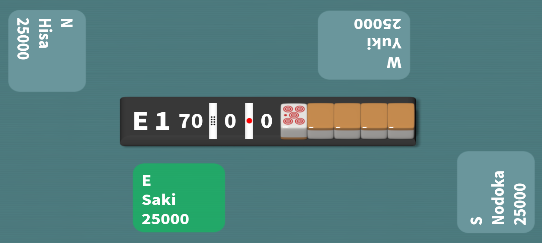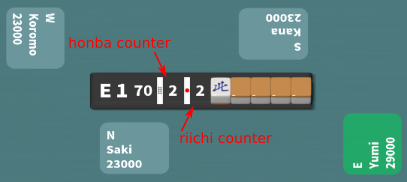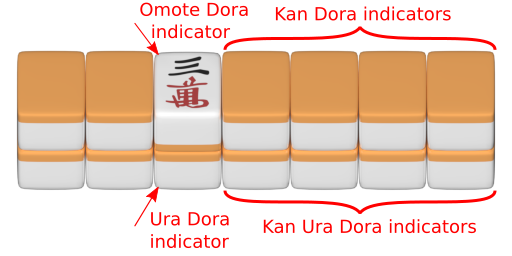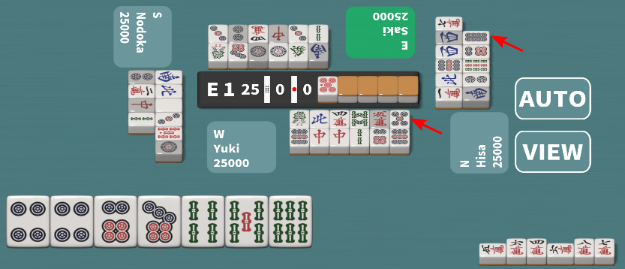Game Rules
A very brief introduction to riichi mahjong (Draft)
The rules of riichi mahjong are quite complicated. The purpose of this guide is to give beginner players the most basic knowledge that would enable them to start the game, and to learn mahjong during the game.
Riichi Mahjong is a Japanese version of Mahjong, a 4-player board game initially originated in China.
Mahijong is played with tiles, of which there are 34 different types. Each of these types, in turn, is represented by 4 tiles, so there are a total of 136. The tiles are divided into groups representing three suits: manzu, pinzu, souzu and honor tiles.
Tiles 1 and 9 of each suit are called terminals, and tiles 2 - 8 are called simple. Honor tiles, in turn, are represented by wind tiles (East, South, West, North) and dragon tiles (White, Green, Red).
East South West North
White Green Red
There is also a variant of the rules according to which one of the fives of each suit is red.
The game of riichi mahjong can consist of either one round (Eastern) or two (Eastern and Southern). The corresponding wind is called the round wind. Each round lasts a minimum of 4 hands. The seating of the players at the table is determined by lot: each player draws one of the wind tiles, and they are seated according to the selected wind (seat wind):

In computer implementations of riichi-mahjong (for example, in R Mahjong), the initial placement of players and the distribution of tiles is randomly determined by computer.
At the beginning of the hand, the tiles are mixed and a wall is built from them. The so-called dead wall, consisting of 14 tiles that are not directly used in the game, with the exception of complementary tiles after the announcement of the kan, stands out from the formed wall. Most of these tiles can be used as the dora indicator. The dora indicator indicates a dora tile - the next tile in order.



Players get 13 tiles each. These tiles form a mahjong hand. Players sit accordingly in the following order counterclockwise: east, south, west and north. Players take their turns in turn also counterclockwise.
The game starts when a player sitting in the east (dealer) takes the first tile from the wall. If he (she) does not have a completed hand, he must discard one of the tiles. Each player takes one tile from the wall in turn, and if his hand is not completed, discards one tile. In addition, under certain conditions, each player may request a tile that has just been discard by another player. The player’s task is to collect a hand containing 4 sets and a pair (with the exception of Chitoitsu and Kokushi musou) earlier than the others.
At the beginning of the game, all players have the same number of points (usually 25,000). At the end of each hand, in accordance with its results, players either lose or gain points. The winner is the one who scores the most points by the end of the game.
There are three types of sets:
- Shuntsu (sequence) is a set consisting of three consecutively numbered tiles of the same suit, for example:
- Koutsu (Triplet) is a set of tiles consisting of three tiles of the same type, for example:
- Kantsu is a set of tiles consisting of four tiles of the same type, for example:
Unlike Shuntsu and Koutsu, four tiles of the same type in the hand themselves are not Kantsu. The player must explicitly declare it by saying Kan. After that, the player takes an additional tile from the dead wall so that he can collect 4 sets and a pair (now it is 4 + 3 + 3 + 3 + 2 = 15 tiles).
For quick hand collecting, you need to understand the principles of effective set collection. So, for example, there are three basic configurations (three presets):
- Ryanmen (open or two sided wait)
- Kanchan (closed wait)
- Penchan (edge wait)
Among these configurations, the most effective the ryanmen pattern. It can be turned into a sequence by taking eight tiles.
Then comes the kanchan. It can be turned into a sequence by taking four tiles. It is more effective than penchan in that it can be easily turned into a ryanmen by taking the appropriate tiles.
Penchan is the least effective. A description of the effectiveness of collecting hands is beyond the scope of this brief introduction. For those interested in a deeper understanding of the subject we advise you to pay attention to the excellent (and completely free) book by Daina Chiba.
In addition to taking a tile from the wall, a player can claim a tile just discarded by another player if this completes the set or his entire hand. Accordingly, there are 4 types of declarations that a player can make for discarded tiles.
To complete the sequence, the player to the right of the player who discarded a tile may claim the tile and declare chi. To complete the triplet, any player can claim a tile that has just been discarded and declare pon. Kan can work like pon. This kan is called daiminkan (open kan).
In addition, there are two additional types of kan: ankan (closed kan) and showminkan (added kan). Closed kan is formed when a player takes the fourth tile of a certain type from the wall. Such kan does not have to be declared immediately, when forming. With ankan, the hand remains closed. The player can declare shouminkan (added kan) when the player previously declareded pon, taking the fourth tile from the wall.
After getting the discarded tile, the player’s hand becomes open. Usually the value of an open hand is less than a closed hand.
It should be noted that the declaration of chi, pon, kan (in the case of daimankan) leading to the opening of the hand may break the normal order of moves, and they continue with the player who made the declaration.
Upon declaration, the claimed tile is placed horizontally relative to other tiles of the formed set and is positioned so that it is clear which player discarded it. All tiles of the formed set are placed face up to the right of the main hand.
![]()
![]()
![]()
![]()
![]()
![]()
![]()
![]()
![]()
![]()
![]()
![]()
![]()
![]()
After kan declaration in the dead wall, another dora indicator (Kan Dora indicator) is revealed. The presence of dora in the winning hand increases its value by 1 han.
There is also a fourth type of declaration, when a tile discarded by another player does not complete the set, but the whole hand. This will be discussed in more detail below.
Winning hands have different values in hans depending on the presence of one or another yaku in them. The winning hand in riichi mahjong must have at least one yaku. What is yaku? Yaku - these are specific combinations of tiles in the hand or the conditions necessary in order to collect a winning hand. Different yaku have different value. Many yaku require hands to remain closed. Other yaku are allowed with both a closed and an open hand, but often have a lower cost when the hand is open. A hand can have several yaku, and their values are summed up to 13 han. A complete list of yaku is available here: http://arcturus.su/wiki/List_of_yaku
The most common yaku combinations (and their value for a closed / open hand):
- Yakuhai - pon composed of dragon tiles or winds of a seat / round (1⁄1):
- Tanyao - all simple (no tiles with numbers 1 and 9, dragons and winds) (1⁄1):
- Iipeikou - (closed hand contains two identical sequences) (1 /):
- Chanta - all sets and a pair contain at least one terminal or honor tile (2⁄1):
- Pinfu is a closed hand without fu. Ryanmen wait (1 /):
- Toitoi - all sets - triplets (2⁄2):
- Honitsu - is a single suit hand mixed with some honor tiles (3⁄2):
- Chiitoitsu - seven distinct pairs in a closed hand (2 /):
In addition to yaku combinations, there are yaku conditions (or situations). One of these yaku conditions is riichi (see below).
Probably the most known yaku condition (after riichi) is rinshan kaihou - taking the winning tile from the dead wall after the kan declaration. Another well-known yaku condition - haitei raoyue - winning on the last tile drawn from the wall.
There are also varieties of yaku called yakuman. Among the most known is Kokushi musou.
The presence of yakuman(s) in the hand gives a value of 32000⁄48000 points (for the non-dealer / dealer).
Dora tiles are not yaku, although they increase the value of the hand by one han. When playing with red fives, each of these fives in the hand is considered as an additional dora.
Since the winner is determined by the total number of points scored in all hands, as well as the requirement to have yaku in the winning hand, in order to play effectively it is highly desirable to know all yaku and their han value.
A hand that lacks one tile until it is completed is called tenpai (or a ready hand). A player may claim a tile discarded by another player if he completes his hand and declare ron - a win on the discard of another player. The player can also end the game by declare tsumo if he has taken the winning tile from the wall. It should be noted that a player whose discard results in ron declaration by another player must pay the winner the full amount of the win (i.e., he pays for all). In the case of a win by tsumo, payments to the winner are divided among all other players.
The hand may end either in someone victory or in a draw. A draw can be exhaustive ( when all the tiles from the wall are drawn and no one has collected 4 sets and a pair with at least one yaku) and abortive (early completion of hand session). You can find out about the types of abortive draw here: http://arcturus.su/wiki/Tochuu_ryuukyoku
After the end of the hand, if special conditions are not met, in the next hand, the first move passes to the next (counterclockwise) player (he becomes seated in the east, i.e. the dealer). Special conditions are:
-
An abortive draw.
-
An exhaustive draw when the current dealer has a ready (tenpai) hand towards the end of the hand session.
-
A victory of the current dealer.
In addition, every time a draw occurs, as well as when the current dealer wins, a special counter - honba increases by one. When any non-dealer wins a hand, then the honba count resets back down to zero. Each unit of honba counter is multiplied by a certain number of points (usually 300) which are added to the payouts.

When a player collects a closed ready hand (tenpai) he can declare riichi. After that, he must place a deposit (1000 points stick) in front of his hand and discard a tile that does not destroy his tenpai. In this case, the discarded tile is rotated 90 degrees to indicate the moment when riichi was called.

After declaring riichi, the player’s hand remains unchanged. The player simply waits for the winning tile, and discards all non-winning ones. The player can also win by the call ron, from discard of another player, if he is not in furiten (see below). A player who declares riichi may however declare Kan (closed Kan) if the 4th tile taken does not change his winning waits and hand composition. For more information, see http://arcturus.su/wiki/Kan#Kan_during_riichi
When a player who declares riichi wins, he opens the lower tiles of the dead wall located under the open dora indicators (under the Omote-Dora indicator and under the open Kan-Dora indicators, if any):

These tiles are the so-called ura-dora and kan-ura-dora indicators work like the previously reviewed dora indicators.
If the player who declares riichi wins, he returns the deposit to himself. In the event of a draw, the deposit remains on the table until the next winning player takes it.
As stated above, riichi is yaku. The declaration of riichi by another player signals that he is in tenpai. Therefore, you should avoid discarding tiles on which the player declaring riichi can declare ron.
Regardless of whether the player declared riichi or not, he cannot declare ron if at least one of the winning tiles for which he has an waiting is in his own discard. This state is called furiten.

So in the screenshot, Yuuki is in a furiten state, since one of the tiles for which she has an waiting is in her discard, and therefore she cannot declare ron on the tile discarded by Hisa.
This condition is called permanent furiten. The player can get out of this state only by changing the hand, accordingly changing the winning wait (of course, if he did not declare riichi, when the hand cannot be changed). In furiten, a player can only win by tsumo.
In addition to permanent, there is also temporary furiten. It occurs when a player, while in tenpai, does not declare ron on the discard of another player. In this case, he is in furiten until his next discard. The back side of temporary furiten is that if the player on the left discards a tile and no one declares a ron on it, for the current player the discard of the exact same tile will be absolutely safe.
Finally, if the player declared riichi and after that did not declare ron when the other player discarded the winning tile, then he is furiten until the end of the hand and can only win by tsumo. Thus, any type of tile already in discard after declaring riichi is safe relative to the player declaring riichi.
Consider now scoring. Scoring in richi mahjong is quite complicated. Fortunately, in computer implementations of riichi mahjong (for example, in R Mahjong), players are spared the need to manually count points.
Nevertheless, it should be noted the general principles used in scoring. Usually, special tables are provided for the manual calculation of points. At the same time, for a better understanding of the scoring mechanism, it is useful to know that when calculating points, the following formula is used:
$$\large\color{red}{base = fu*2^{2+han}}$$
The value calculated using this formula gives the so-called base value of the hand. As previously mentioned, han are awarded for yaku and for dora in the hand. As for fu, they are determined taking into account the composition of the hand and the type of win:
- 30 fu for ron with a closed hand,
- 25 fu for chiitoitsu (seven pairs), -20 fu in all other cases.
Additionally, fu are accrued for:
- koutsu and kantsu,
- a couple of tiles suitable for yakuhai,
- kanchan, penchan and waiting for a pair (tanki),
- for tsumo with any hand except pinfu,
- for the lack of any fu in the open hand (the so-called open pinfu).
For more information on calculating fu, see page: http://arcturus.su/wiki/Fu
If the dealer wins by ron, the base value is multiplied by 6 and rounded up to hundreds. In the case of winning a non-dealer by ron, the base value is multiplied by 4 and rounded up to hundreds.
If the dealer wins by tsumo, the base value is multiplied by 2 and rounded up to hundreds. If a non-dealer wins by tsumo, for non-dealer losers, the base value is rounded up to hundreds. For the losing dealer, the base value is multiplied by 2 and rounded up to hundreds.
At the end of the game, “raw points“ are converted to the so-called “end game score.“ Refer to http://arcturus.su/wiki/Oka_and_uma
References
-
Riichi Mahjong Wiki— probably one of the best sources of riichi mahjong rules in english.
-
Riichi Mahjong Strategy Books written by Daina Chiba. This book is freely available. Highly recommended.
-
Riichi seminar — Daina Chiba seminar. For more advanced players.
-
USPML — many materials about riichi mahjong.
-
Osamuko’s Mahjong Blog — many articles about riichi mahjong, events, competitions, etc.